The Intel Comet Lake Core i9-10900K, i7-10700K, i5-10600K CPU Review: Skylake We Go Again
by Dr. Ian Cutress on May 20, 2020 9:00 AM EST- Posted in
- CPUs
- Intel
- Skylake
- 14nm
- Z490
- 10th Gen Core
- Comet Lake
Power
We kind of gave a sneak preview on the front page with our frequency graph, but the short answer as to whether these new Core i9 processors really need 250 W for 10 cores is yes. Intel sent us details on what it has determined should be the recommended settings for its K processor line:
- Core i9-10900K: TDP is 125 W, PL2 is 250 W, Tau is 56 seconds
- Core i7-10700K: TDP is 125 W, PL2 is 229 W, Tau is 56 seconds
- Core i5-10600K: TDP is 125 W, PL2 is 182 W, Tau is 56 seconds
For those not used to these terms, we have the TDP or Thermal Design Power, which is meant to be the long-term sustained power draw of the processor at which Intel guarantees the base frequency of the processor – so in this case, the Core i9-10900K guarantees that with a heavy, long-running workload it will max out at 125 W with a frequency of at least 3.7 GHz (the base frequency).
The PL2 is known as the turbo power limit, which means that while the processor is allowed to turbo, this is the upper power limit that the processor can reach. As mentioned on the first page of this review, the value for PL2 is only a suggested guide, and Intel lets motherboard vendors set this value to whatever they want based on how well the motherboard is designed. Sometimes in laptops we will see this value lower than what Intel recommends for thermal or battery reasons, however on consumer motherboards often this value is as high as it can possibly be.
The final term, Tau, is meant to be a time by which the turbo can happen. In reality the TDP value and the Tau value is multiplied together to give a value for a ‘bucket’ of energy that the processor can use to turbo with. The bucket is refilled at a continuous rate, but if there is excess energy then the processor can turbo – if the bucket is being emptied at the same rate as it is refilled, then the processor is down at the long-term TDP power limit. Again, this is a value that Intel recommends and does not fix for the vendors, and most consumer motherboards have Tau set to 999 seconds (or the equivalent of infinite time) so the processor can turbo as much as possible.
Note, when we asked Intel about why it doesn’t make these hard specifications and how we should test CPUs given that we’re somewhat enable to keep any motherboard consistent (it might change between BIOS revisions) for a pure CPU review, the response was to test a good board and a bad board. I think that on some level Intel’s engineers don’t realize how much Intel’s partners abuse the ability to set PL2 and Tau to whatever values they want.
All that aside, we did some extensive power testing on all three of our CPUs across a number of simulation and real-world benchmarks.
Core i9-10900K Power
Through our tests, we saw the Intel Core i9-10900K peak at 254 W during our AVX2-accelerated y-cruncher test. LINPACK and 3DPMavx did not push the processor as hard.
The more real-world tests, AI Benchmark and Photoscan, showed that in a variable operation workload mixing threads, we are more likely to see the 125-150 W range, with spikes up to 200W for specific operations.
For users interested in the voltage for our Core i9-10900K, we saw the processor peak at 1.34 volts, however even during an AVX2 workload it was nearer to 1.25 volts.
Intel Core i7-10700K
The Intel Core i7-10700K is rated by Intel to have a peak turbo power of 229 W, however our sample peaked at 207 W during y-Cruncher. LINPACK achieved similar results, whereas 3DPMavx was nearer 160 W.
Our AI Benchmark power wrapper failed for the 10700K due to a configuration issue, but the Photoscan ‘real world’ power test put the processor mostly in the 100-125 W range, peaking just below 150 W in a couple of places.
Intel Core i5-10600K
Intel’s Core i5-10600K has a recommended PL2 of 182 W, but we observed a peak of 125 W in y-Cruncher and 131 W in LINPACK.
We actually saw our AI Benchmark real-world test hit 130 W as well, while Photoscan was nearer the 60-80 W range for most of the test.
The full set of power graphs can be found here:
In terms of overall peak power consumption, our values look like this:
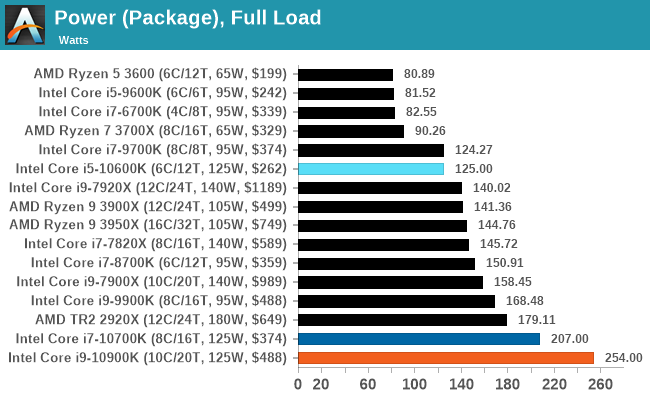
Note, 254 W is quite a lot, and we get 10 cores at 4.9 GHz out of it. By comparison, AMD's 3990X gives 64 cores at 3.2 GHz for 280 W, which goes to show the trade-offs between going wide and going deep. Which one would you rather have?



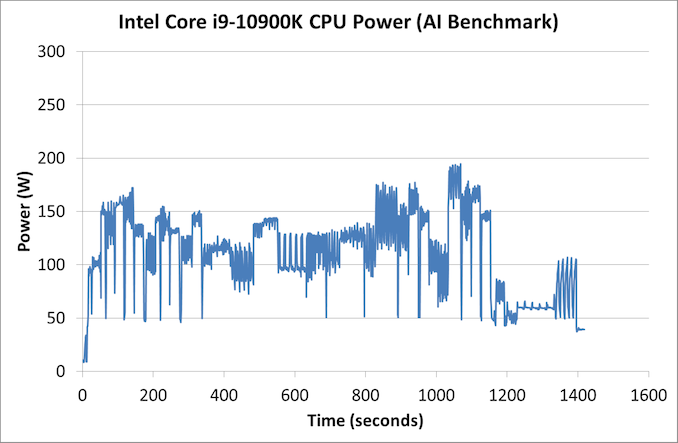
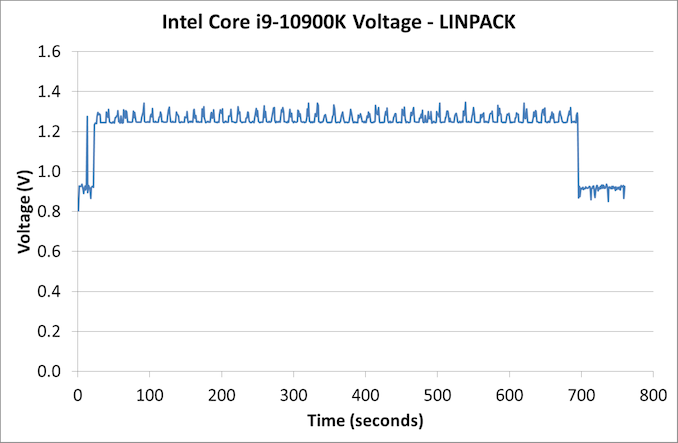
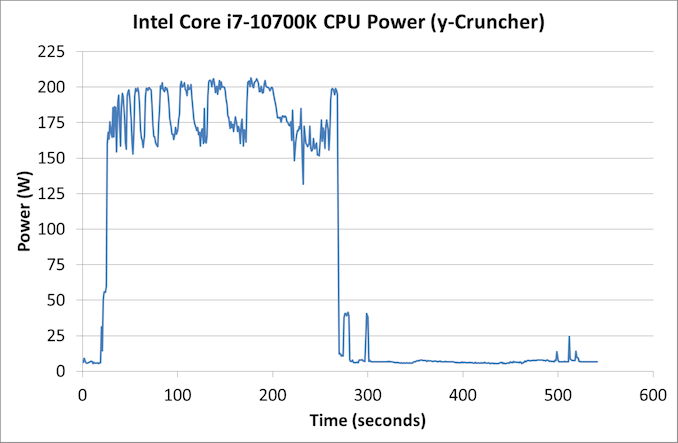
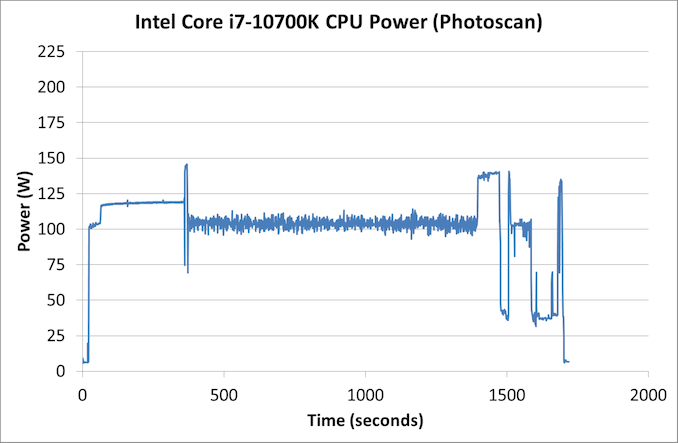
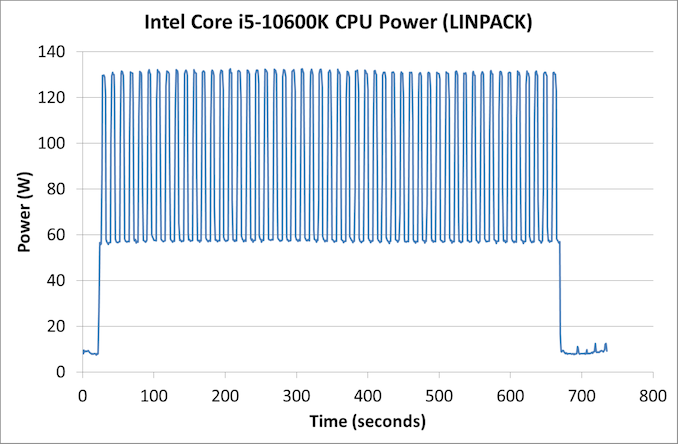
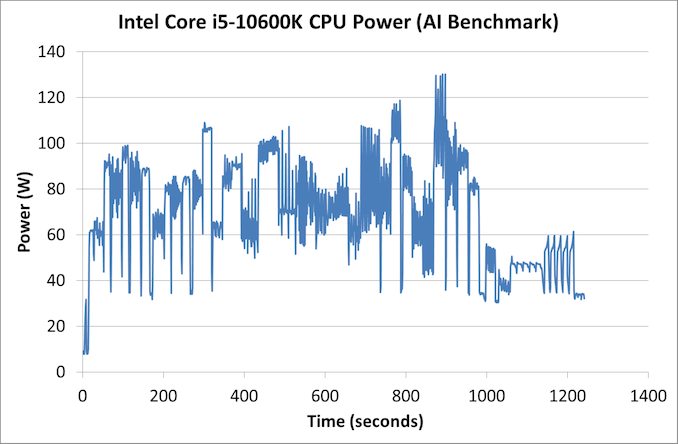














220 Comments
View All Comments
Boshum - Wednesday, May 20, 2020 - link
Pfft. You are hilarious.Spunjji - Tuesday, May 26, 2020 - link
Maxipad, the latest in the line of Gondalf imitators.Adm_SkyWalker - Wednesday, May 20, 2020 - link
Once again I find myself debating if I should upgrade. My current i7-6950X has held up better than I thought it would. I guess it's another year or two wait for me.Boshum - Wednesday, May 20, 2020 - link
I would be good with a beast like that for 5 more years.Icehawk - Saturday, May 23, 2020 - link
I’d wait until a component like mobo dies, that’s what got me to move from a 3770 about a year ago to a 8700 - mobo died and they were pricy and old. Replaced my wife’s i5 from same gen with a 3900X though recently and gave her the intel box. I’m a gamer but I do a lot of encoding so felt AMD offered a better mix and allows me to use my 450W fanless PSU. But aside from encoding speed I barely notice a difference from that 3700.Dug - Wednesday, May 20, 2020 - link
The problem with all these charts is that they are inconsistent.There are so many variables that aren't shown that it doesn't make sense to show these.
Most of this has to do with how motherboards handle the cpu's and what their default settings do.
There can be a 15% swing in AMD motherboard default settings between brands. Not to mention things like pbo on or off, infinity fabric, memory timings, etc.
I don't know about the Intel side. I remember their settings made less difference unless it was just cpu clock speed.
shady28 - Wednesday, May 20, 2020 - link
Agree with the sentiment, but you kinda stacked the deck with that last statement.Most of the Z490s are now supporting much higher speed RAM (up to DDR4-5000) and even intel 9th gen were good at overclocked RAM, while AMD systems rarely get above 3600Mhz. It shows if you look at something like PCMark 10 where the top 100 systems on almost all of the charts is completely dominated by intel. All of them are overclocked of course, but all of the top AMD systems are also overclocked.
What I would like to see is something along the lines of a i5-10600K vs AMD 3600 vs AMD 3600X, but not using 'all the same components other than mobo and CPU'. Take those 3 chips and build the fastest system you can with them. Use that PCI 4.0 NVMe and GPU on AMD, use that 4800Mhz CAS 18 RAM on the Intel. See what happens.
mrvco - Wednesday, May 20, 2020 - link
Ok, part of me would be curious to see what Intel could (or couldn't) do with an 11th Gen spin of their 14nm process.Findecanor - Wednesday, May 20, 2020 - link
The "Security" portion of this article is not really comprehensible. I can't guess what the author is thinking. The author needs to write it down in actual words what these things mean.Security on Intel processors is what is holding me off from buying any Intel CPU for the time being.
I consider myself pretty knowledgeable about the actual vulnerabilities themselves, and how they work, and how they can be mitigated -- in theory --, but if I have not kept up with every little tidbit of news about security on Intel's processors in particular, that portion of the article tells me absolutely NOTHING.
quadibloc - Wednesday, May 20, 2020 - link
These chips are impressive, and for people with a need to build a system today, and a preference for Intel, they are reasonably competitive. So I am favorably impressed, even if AMD would remain my own choice at the moment. I still do believe that in the long run, Intel does have the means to regain leadership, so that in a year or two or five, AMD will be back to being in second place (but in second place like the previous generations of Ryzens, not like the Bulldozer years). I don't know, though, if even Intel will be able to keep up at the process end; even it may have to go fabless after 10nm, which would have significant implications for the industry.